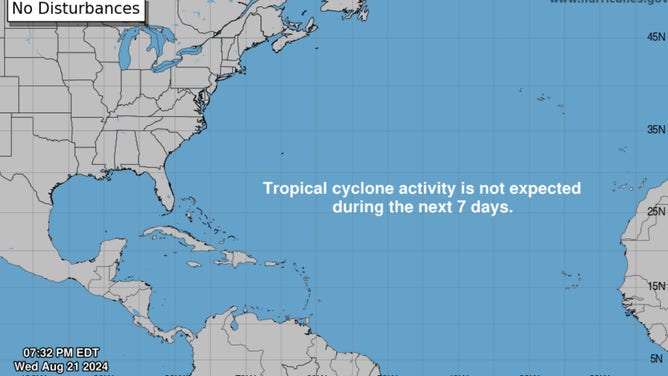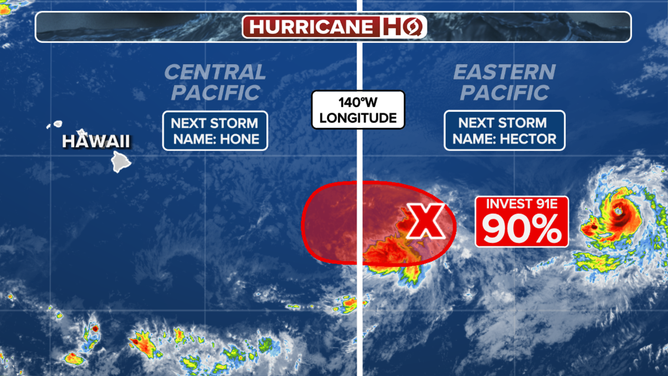Hurricane Hunters head to Hawaii as multiple tropical threats swirl in Pacific
Hurricane hunter aircraft have flown into Alberto, Beryl, Chris, Debby and Ernesto during the 2024 hurricane season in the Atlantic basin. Increasing in frequency, planes will investigate atmospheric river events over the Pacific during the winter.
Bryan Norcross analyzes tropical activity in Pacific, lack of activity in Atlantic
FOX Weather Hurricane Specialist Bryan Norcross breaks down what the increase in tropical activity in the Pacific Ocean means for Hawaii while also explaining why there's a lull in activity in the Atlantic Ocean on Wednesday, Aug. 21, 2024.
HONOLULU - A late August deployment to Hawaii will not be a time for relaxation for Hurricane Hunter aircraft, as multiple agencies closely monitor the potential threats that developing cyclones could pose to the islands.
According to the National Weather Service in Honolulu, the agency, in consultation with the National Hurricane Center and other federal agencies, has requested aircraft to investigate and monitor a disturbance currently known as Invest EP91.
The disturbance is entering the central Pacific, and questions remain about how closely it will approach the islands and what the potential impacts might be.

(FOX WEATHER)
NWS meteorologists emphasized that the aviation missions will be crucial in understanding the strength of the disturbance and how powerful the system will become.
Data collected by the aircraft will be fed into computer systems, where forecasters hope more accurate outputs are produced.
"The Pacific and Atlantic Oceans are data-sparse environments as they lack radar and weather balloons in the area," Maj. Grant Wagner, a 53rd WRS mission commander, stated previously after a mission in the realm of the central Pacific. "We are able to get into the storm, find the center, and get that ground-truth data that assists with movement and intensity forecasts. The data we collect can improve a forecast by anywhere from 15-25%."
While deploying aircraft to Hawaii for tropical cyclones is not unusual, it is relatively infrequent. In 2023, the Air Force's Hurricane Hunters didn’t fly through any systems that triggered alerts for the islands but did investigate five cyclones off the coast of Mexico.
THIS HURRICANE HUNTER PLANE USES 3 RADARS TO SEE STORMS IN UNIQUE WAYS
FOX Weather gets inside look at how hurricane hunters gather life-saving information by flying into the storm
The 2024 Atlantic hurricane season begins on Saturday, and forecasters are preparing for what could be an extremely active season. FOX Weather Correspondent Brandy Campbell got an inside look at how hurricane hunters prepare to fly into dangerous hurricanes to gather potentially life-saving information.
So far in 2024, hurricane hunter aircraft have investigated and sampled the environments around Alberto, Beryl, Chris, Debby and Ernesto, but all were Atlantic-based storms.
Invest EP91, which could strengthen into a tropical storm over the next week, would be the first cyclone this season to be investigated by either a NOAA Gulfstream jet or a U.S. Air Force WC-130J while over the Pacific.
With the Atlantic basin as quiet as it ever is in late August and no tropical cyclone development expected for at least the next week, the downturn in activity is allowing agencies to devote multiple resources to the Pacific - an occurrence that might not have been possible if there were other brewing threats.

Atlantic basin threat map
(NOAA)
The first aircraft is expected to depart Southern California on Thursday to sample the atmosphere around the disturbance before landing in Hawaii during the late evening hours.
The planes are expected to stay at least through the weekend, but that will depend on the actual weather conditions on the islands.
With few areas to protect aircraft from a cyclone, if the islands do fall under direct threat, the planes would likely be redeployed to a safer airstrip, ending constant observations.
"During a tropical storm or hurricane, a 53rd WRS crew can fly through the eye of a storm four to six times. During each pass through the eye, they release a dropsonde, which collects temperature, wind speed, wind direction, humidity and surface pressure data," specialists stated.

Tracking the tropics in the eastern and central Pacific.
WATCH: HURRICANE HUNTER TALKS TO FOX WEATHER WHILE FLYING INSIDE HURRICANE IAN
The NWS office said they are addressing each system as it comes, even though the possibility exists of one or two cyclones impacting the islands.
Whether or not the aircraft will remain in position for Hurricane Gilma, currently swirling just to the east of 91E, will depend on logistics and how active the Atlantic becomes in the final days of August.
Similar to the hurricane season in the Atlantic, tropical cyclone seasons in both the central and eastern Pacific regions run through Nov. 30.

(FOX WEATHER)

